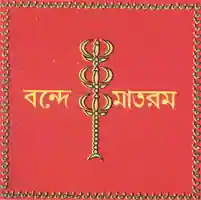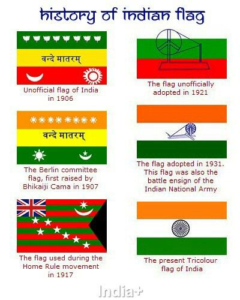In news– It was on July 22, in 1947 that the Constituent Assembly of India adopted the National Flag and now it marks the 75th anniversary of the historic day.
History of Indian National Flag-
- The first version of the Indian flag came in the year 1904 when Sister Nivedita, more fondly called as Bhagini Nivedita, a disciple of Swami Vivekananda designed a yellow and red flag with a ‘Vajra‘ in the centre and ‘Vande Mataram’ written in Bengali in the centre.

- The Unofficial national flag in India is said to have been hoisted on August 7, 1906, in the Parsee Bagan Square (Green Park) in Calcutta now Kolkata. The flag was composed of three horizontal strips of red, yellow and green.

- During the session of the All India Congress Committee which met at Bezwada in 1921 (now Vijayawada) an Andhra youth prepared a flag and took it to Gandhiji.
- It was made up of two colours-red and green-representing the two major communities i.e. Hindus and Muslims. Gandhiji suggested the addition of a white strip to represent the remaining communities of India and the spinning wheel to symbolise progress of the Nation.
- The flag was adopted in 1931. This flag was also the battle ensign of the Indian National Army.
- The year 1931 was a landmark in the history of the flag. A resolution was passed adopting a tricolour flag as our national flag. This flag, the forebear of the present one, was saffron, white and green with Mahatma Gandhi’s spinning wheel at the centre.
- On July 22, 1947, the Constituent Assembly adopted it as the Free India National Flag. After the advent of Independence, the colours and their significance remained the same.
- Only the Dharma Charkha of Emperor Asoka was adopted in place of the spinning wheel as the emblem on the flag.
What happened in the Constituent Assembly on July 22, 1947?
- According to the official record of the proceedings, the Constituent Assembly met in the Constituent Hall in New Delhi on July 22, 1947, with Dr Rajendra Prasad in the Chair.
- The Constituent Assembly had been meeting since December 9, 1946, and had by then discussed a range of subjects.
- The Chair announced that the first item on the agenda was “a Motion by Pandit Jawaharlal Nehru about the Flag”. Thereafter, Nehru rose to move the following Resolution: “Resolved that the National Flag of India shall be horizontal tricolour of deep Saffron (Kesari), white and dark green in equal proportion. In the centre of the white band, there shall be a Wheel in navy blue( symbolised the common man) to represent the Charkha. The design of the Wheel shall be that of the Wheel (Chakra) which appears on the abacus of the Sarnath Lion Capital of Asoka.
- He had said that the diameter of the Wheel shall approximate to the width of the white band and the ratio of the width to the length of the Flag shall ordinarily be 2:3.
- At the end of the day, the record says, “The motion was adopted, the whole Assembly standing.”
- The Flag defined by the Resolution, Nehru said, “was adopted, not by a formal resolution, but by popular acclaim and usage, adopted much more by the sacrifice that surrounded it in the past few decades”, and that the Constituent Assembly was “in a sense only ratifying that popular adoption”.
- He clarified that the Flag must not be thought of in communal terms, and that when the Flag was devised, there was no communal significance attached to it.
Note:
The government has envisioned the ‘Har Ghar Tiranga’ (tricolour at every home) exercise in the run up to the 75th anniversary of India’s independence.
Further reading: https://journalsofindia.com/amendment-to-flag-code-of-india-2022/
















